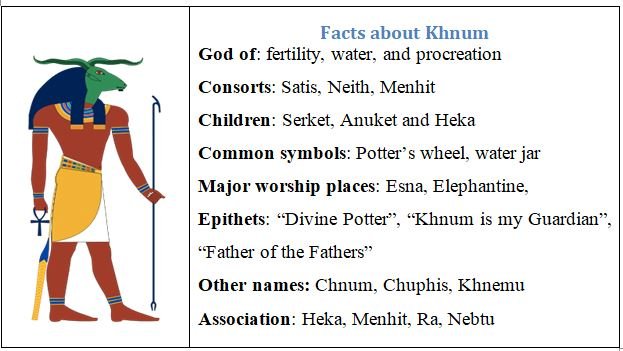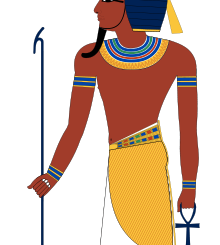Egyptian God Khnum: Myths, Origin Story, Powers, & Importance

Khnum myths and facts
For more than three millennia, several Egyptian gods and goddesses rose to quite lofty prominence among ancient Egyptians, but very few reached the reverence and appeal of Khnum, the ram-headed god of creation. Also known as Khnoumis or Khnemu, Egyptian god Khnum was famed in ancient Egyptian religion for having molded human beings from clay. Additionally, he was associated with the Nile River, with many describing him as the god of the source of the Nile.
The article below explores major myths and facts associated with the origin story, worship and power of Khnum.
Family, consorts, and offspring
Khnum was undoubtedly one of the earliest-known deities of the Egyptian pantheon. As a deity of procreation, he was not born; rather he was the force that fashioned the cosmic egg from which everything emerged from at the beginning of time.
The ancient Egyptians believed that his consort was fellow goddess Satet (Satis), an important deity in Elephantine (an island on the Nile River in the southern border of Upper Egypt). Similar to Khnum, Satis was associated with the River Nile, as many believed she was the deity responsible for the river’s annual flooding. As a fertility goddess, some ancient historians equated her to ancient Greek goddess Hera or the Roman goddess Juno.
In other accounts of the myth, Egyptian fertility goddess Nebtuwi (Nebtu) was seen as Khnum’s consort. There were also some ancient Egyptians that believed that his wife was instead creator and mother goddess Neith.

Khnum’s consorts (from left to right): Neith, Heqet, and Meskhenet
Epithets
Egyptian pharaoh Khufu, the famous builder of the Great Pyramid of Giza, absolutely revered Khnum. As a matter of fact, one of Khufu’s names read as “Khnum is my Protector”. Other epithets of Khnum include: “Lord of the First Cataract”, “Guardian of Elephantine”, and “Divine Potter”.
“Father of the Fathers”
According to some ancient texts from the city of Esna, Khnum and his consort Neith were the parents of the sun god Ra. As a result, Khnum was described as the “Father of the Fathers”, while creator goddess Neith was seen as the “Mother of the Mothers”.
At some point in ancient Egypt, Ra’s properties were merged with Khnum’s, forming a deity called Khnum-Ra (or Khnum-Re).
Symbols and depictions

Khnum, the Egyptian god of procreation and the source of the Nile River, was usually depicted with the head of a ram
The typical depiction of Khnum sees him as a ram with horizontal twisting horns. In other cases, he is seen as a well-built man with a ram’s head. In almost every depiction of him by the ancient Egyptians, a potter’s wheel can be seen. Aside from the potter’s wheel, other important symbols of the god are a jar and water.
Khnum’s Power
Associated with the Nile River, Khnum was believed to be chiefly responsible for the annual flooding of the Nile. The entire ancient Egyptian society depended on Nile’s flooding as it deposited very rich silt and clay sediments that fertilized the farmlands along the river. As a result, ancient Egyptians revered him as the force that made their crops grow. And by extension, they believed he was the being who molded humans from the clay sediments of the Nile.
It was believed that after the molding of the human body was complete by Khnum, his consort Meskhenet would breathe life (“ka”) into the body at the moment of birth.
As the “Divine Potter”, Khnum also molded a great number of Egyptian deities at his potter’s wheel.
Worship
Worship of Khnum began around 3,000 BCE, i.e. around the Old Kingdom Era. This makes him one of the earliest-known Egyptian gods.
His worship centers were mainly in two very famous ancient Egyptian cities – Esna and Elephantine. Both of those cities were very important river places, especially Elephantine which many Egyptians believed as the source of Nile River.
During the New Kingdom Era, there were many holy sites along the west bank of the Nile dedicated to Khnum.
At Elephantine (near present-day Aswan), Egyptian god Khnum was part of a triad of gods that included his consort Satis and Anukis.
At the various cults in Esna, south of Thebes, Khnum had devout followers who often worshipped him along with deities such as Neith, an early Egyptian goddess of creation, mothers and weaving, and Heka, a deity of medicine and magic.

Worship of Khnum | Ramesses II’s rock-cut Temple of Beit el-Wali (“House of the Holy Man”) in Nubia houses statues of Khnum, his consort Satis, and his son Anukis
Association
As a creator deity, Khnum was associated with a plethora of Egyptian gods and goddesses. For example, the god Ptah, god of craftsmen and patron deity of Memphis, was associated with potter’s wheel Khnum used in molding the cosmic egg. In Ptah’s case, Egyptians believed that he created the heaven and earth using that potter’s wheel.
Other deities that often get associated with this god include: the goddess Maat (goddess of truth and justice) and Thoth (the divine scribe and god of knowledge and wisdom). Khnum has also been associated with a host of ancient Egyptian fertility deities, including Min, Neith, Nebtu, Heka and Menhit.
More:
Khnum – the guardian of Elephantine
Considering how important the Nile was to ancient Egyptian civilization, it comes as no surprise that a deities were needed to protect it all times, especially at its source. The ancient Egyptian god Khnum was commonly revered as the deity that stood guard at the source of Nile, vanquishing any evil being that attempted to interrupt the flow of the Nile.
The inhabitants of Esna believed that he carried out this divine role of his with the help of deities such as Menhit (a war goddess), Nebtu, and Heka.
Around the Middle Kingdom, there was a temple in Elephantine dedicated to Khnum, his wife Satis and his daughter Anuket (Anukis). Those three deities together made up the famous Triad of Elephantine.
Significance of Khnum in ancient Egyptian religion
According to a number of texts in ancient Egyptian religion, he was the deity who single-handedly molded the Great Cosmic egg. From that egg came forth the sun and everything that exists. For this act of his, ancient Egyptians gave him the epithet “Great Molder”.
After creating the cosmic egg, Khnum went back to his potter’s wheel and molded the human beings out of clay.
The ancient Egyptians believed that Elephantine – one of the Khnum’s worship places – was the source of the Nile. As a result, he became revered as the god of the source of the Nile
More Khnum facts
At the temple of Queen Hatshepsut at Dayr al-Bahri, there is a painting of Khnum sculpting the body and soul of Hatshepsut on his potter’s wheel.
As late as 300 CE, there existed images of him on papyrus scrolls and gnostic gemstones.
In Middle Kingdom Egypt, a significant number of Khnum cult centers also developed at a place called Herwer in Upper Egypt. There, he and his consort Heqet (Heket) were described as the Lord and Lady of Herwer. Some scholars state that his first main cult center developed at Herwer.
In Middle Egypt (an area between Upper and Lower Egypt), he was predominantly worshiped at a place called tuna el-Gebel (also known as the Necropolis of Khnum).
His worship was also common during the Rameside Era, particularly during the reign of Ramesses II. For example, Ramesses II’s rock-cut Temple of Beit el-Wali (“House of the Holy Man”) in Nubia houses statues of Khnum, his consort Satis, his son Anukis, and numerous other deities like Amun-Re and Re-Horakhti.
According to some ancient texts, he was first seen as a female deity due to the belief that he was the one who laid (or molded) the Great Cosmic Egg from everything in the universe emerged from. He molded and shaped humans from clay on his potter’s wheel.
In recent years, a German team of archaeologists unearthed mummified ram of Khnum that are now on display at the Aswan Museum.



























